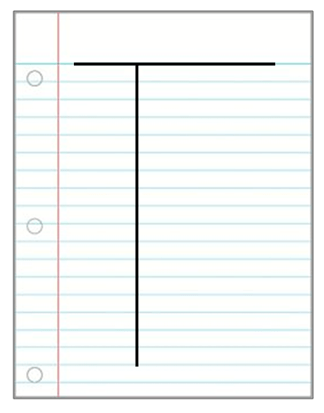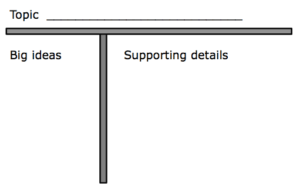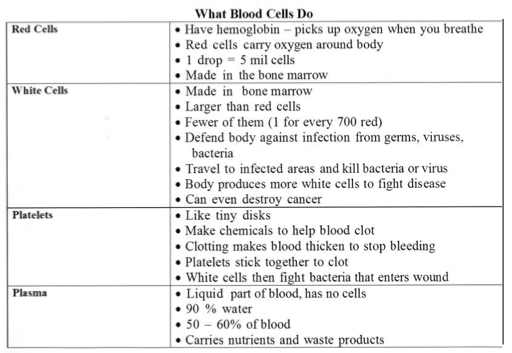Explicit Instruction of Note Taking Skills

Note taking, and two-column note taking in particular, is integrated into several Keys to Literacy professional development offerings. It is used in The Key Comprehension Routine as a strategy for improving reading comprehension. It is used in Keys to Content Writing as a strategy and scaffold for gathering information from sources before writing. It is also used in The Key Vocabulary Routine as a template that can be used to deeply teach academic vocabulary. This post provides some suggestions for teaching note taking.
Why should we teach note taking?
Note taking is a procedure for recording information from anything that is read, said, or done. Taking notes enhances students’ comprehension as they process, organize, and restate the information in their own words. It also encourages metacognition as students must actively search for main ideas and key supporting details. Finally, it is a valuable tool for gathering and organizing information to write from a variety of sources.
Research clearly identifies note taking as an essential comprehension and writing strategy. (Peverly et al., 2007; Graham & Perin, 2007). In particular, the Writing to Read report (Graham & Hebert, 2010), based on a review of the research on the connection between reading and writing, found that teaching students to write notes about text is a highly effective instructional practice for enhancing reading comprehension. The report explains that note taking entails sorting text to determine what is most relevant and paraphrasing this information into written phrases. The report notes:
“Intentionally or unintentionally, note takers organize the abstracted materials in some way, connecting one idea to another, while blending new information with their own knowledge, resulting in new understandings of texts… Taking notes about text proved to be better than just reading, reading and rereading, reading and studying, reading and underlining important information, and receiving explicit instruction in reading practices. “(p. 16)
In addition, there are several Common Core Literacy State Standards (2010) that require students to develop skills related to note taking. Reading standard #1 and writing standard #8 specifically address note taking:
Reading #1: Read closely to determine what the text explicitly says and make logical inferences from it; cite specific textual evidence when writing or speaking and writing to support conclusions drawn from the text.
Writing #8: Gather relevant information from multiple print and digital sources.
Two-Column Note Format
To take notes, students must identify main ideas and key details, paraphrase them using as few words as possible, and record them in a structured format. The two-column format that Keys to Literacy uses was adapted from the Cornell Note System originally developed in the 1950’s at Cornell University for use with college students (Pauk, 1997).
A page of two-column notes consists of a vertical line down a page with a horizontal line at the top, as shown in the visual below. The vertical line is drawn about 1/3 of the way from the left-hand side of the paper. The main ideas are written on the left and associated key details are written on the right. The heading or topic is listed at the top above the horizontal line.

Here are some free resources related to note taking that you can access at the Keys to Literacy website:
- 9-minute training video that presents details about two-column notes at the Keys to Literacy website
- blank note-taking template
Taking Two-Column Notes Using Word Processing
If your students are taking notes using a device such as a laptop or tablet, the best way to set up a page for two-column notes is to use the table function in your word processing program. View the examples at the end of this blog entry. Here are the directions if you are using Microsoft WORD:
- Open up the table feature.
- Insert a table that has 2 columns and approximately 5 rows (the number of rows you need will depend on how many main ideas will be listed in the left column – 1 row for each main idea).
- The table will automatically produce two columns that are the same width. You can change the column width to make the right column (details) wider than the left column (main ideas) by using fixed column width to move the vertical line to the left.
- Type a main idea in one of the cells in the left column, then add related details to the cell in the right column. When you are ready to add another main idea, move to the next cell in the left column and type in the main idea. Then add details in the right column.
- Repeat the steps above until the notes are completed. The cells will expand to accommodate all of your text. You can add or delete rows depending on the number of main ideas you identify.
For additional directions about using the table feature in Word, use the Help tool in your word processing program.
Beyond the Format
Beyond the two-column format, the more challenging part of note taking instruction is teaching students the underlying sub-skills needed to take notes effectively, including:
- main idea skills
- distinguishing between relevant and irrelevant information
- paraphrasing
- writing concisely and using abbreviation
- using visual cues such as arrows, stars, brackets, and underlines to organize notes
- listening and attending skills when taking notes from a lecture, audio, or video source
- integrating information into notes from multiple sources
If you would like to learn more about teaching note taking, please consider taking our online course titled How to Teach Two-Column Note Taking.
Here are three examples of two column notes:




 Joan Sedita is the founder of Keys to Literacy and author of the Keys to Literacy professional development programs. She is an experienced educator, nationally recognized speaker and teacher trainer. She has worked for over 35 years in the literacy education field and has presented to thousands of teachers and related professionals at schools, colleges, clinics, and professional conferences.
Joan Sedita is the founder of Keys to Literacy and author of the Keys to Literacy professional development programs. She is an experienced educator, nationally recognized speaker and teacher trainer. She has worked for over 35 years in the literacy education field and has presented to thousands of teachers and related professionals at schools, colleges, clinics, and professional conferences.
Hello Joan,
I appreciate your resources for ‘Keys to Literacy’. I am a teacher trainer too and very much interested in your ideas about literacy. These resources will come in handy for my teaching and a support for my students. Thank you.
I loved this strategy and it will be very useful as a study skill tecnique. Thank you.
Thank you so much for the comprehensive article and examples!!